
How the Farm to Fork Strategy can Fix our Food System
22.09.2021
An opinion by Sarah Wiener and Tilly Metz , Greens/EFA MEPs.
As the food and farming arm of the European Green Deal, the Farm to Fork strategy aims to push forward the ongoing sustainable transformation of food systems, while ensuring fair economic returns for farmers. It includes twenty-seven measures to make the entire food chain durable: objectives to green our food production, recommendations to the retail sector, food labelling policies for consumers and more.
But some measures, such as a 50% reduction in the use of chemical pesticides by 2030 has sparked major attacks by agro-industrial lobbies.
Despite the backlash from certain industries, can the Farm to Fork Strategy actually fix our food system?
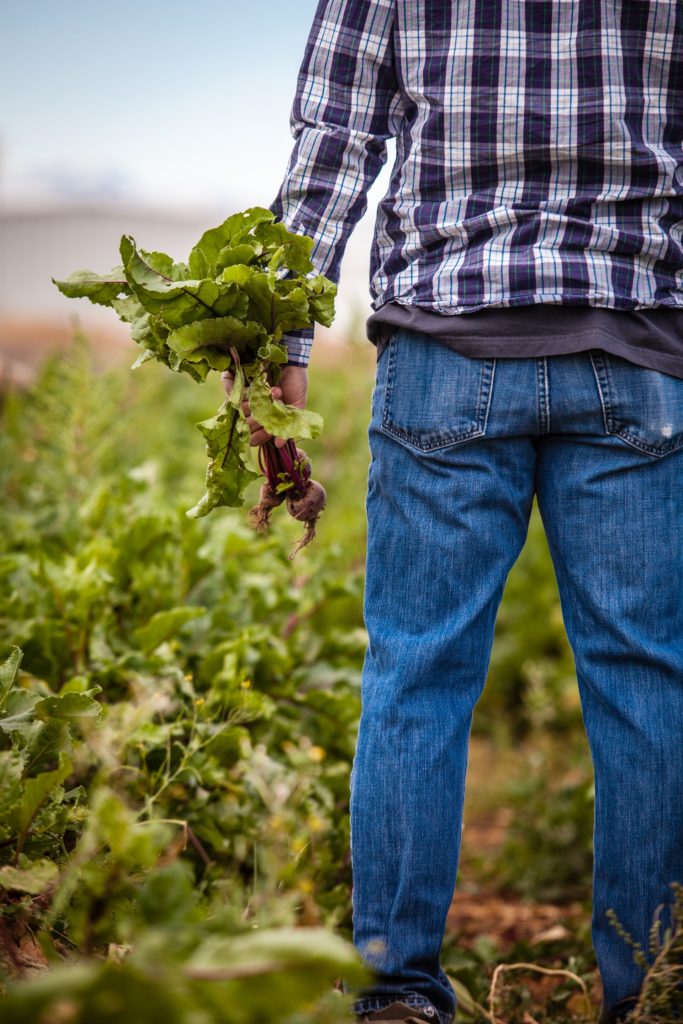
Busting the Myths about the Farm to Fork Strategy
Can we afford to keep the EU food system as it is? Today, food production alone already accounts for almost 30% of the EU’s emissions. But, losses, wastes and inefficiencies are increasing. More than twice as many calories are currently produced by world agriculture than what is ultimately available to consumers.
In May 2020, the European Commission finally decided to take action. Under the umbrella of its flagship program, the EU Green Deal, it launched a fully-fledged strategy that aims to fix our food system, called the Farm to Fork strategy.
However, since the day of the Commission release, powerful agri-industry lobbyists have made apocalyptic predictions about its impact, suggesting that this strategy would be harmful to farmers and our entire food production system.
So will Europe face food shortages with the new strategy, as they suggest? Will all EU agriculture disappear overnight? Of course not.
Sticking with the status quo might seem smart in the short term, but in the long term it will be at the expense of farmers, consumers, and the environment. For years, independent studies have raised startling questions and have shown that our food system urgently needs a new direction. For the Greens/EFA group, the Paris-based research team BASIC has compiled them in a review of literature.
Do chemical pesticides really help farmers to harvest better crops? Do farmers actually earn more when they produce more? Can our food system be good for ecosystems at all? Can the food supply in Europe be climate neutral or even have a positive impact on climate?
Here are the science-based facts and figures to answer these questions.
1. Do synthetic pesticides help farmers secure higher revenues? NO!
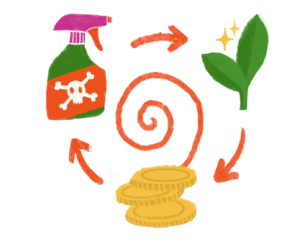
All major agricultural member states of the European Union (except Spain) saw a significant drop in their average gross income for agriculture between 1997 and 2017. This ranged from -6% in Germany down to -33% in Belgium.
If we compare the drop in income for farms with their average spending on pesticides and fertilizers, it clearly shows that the economic efficiency of using these products has decreased by 25% – 27% since 1995.
European farmers are locked in a vicious circle. They are spending an ever-increasing amount of money on pesticides and fertilizers in order to try to offset a decrease in yield (compared to the global average trend) when, in reality, the more they use these products, the further their income decreases.
2. Will reducing synthetic pesticides put farmers’ incomes at risk? NO!
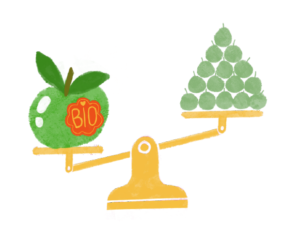
A study of 55 organic crops – grown on five continents, over 40 years – found that despite lower yields, organic agriculture was significantly more profitable (22–35%) than conventional agriculture. Farmers managed to capture high-value markets and achieved 20-24% higher benefit-cost ratios than conventional agriculture {1}.
Although the lower use of synthetic pesticides and fertilizers does lead to a drop in yields, and mechanical weeding requires additional labor, these higher costs are offset by higher prices on the organic market {2}. Plus, they depend much less on subsidies than conventional agricultural systems.
Agro-ecology has proven to be more economically efficient across the EU, thanks to a better level and stability of income and employment. Reducing costs (and therefore the use of synthetic pesticides) and maximising value is “farming common sense”: every euro you earn is one you don’t spend !
3. Is yield the only factor that influences farmers’ income? NO!
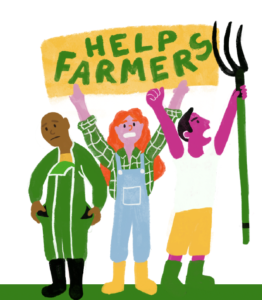
The drop in farmers’ income has less to do with their yield (how much they produce) than with the additional profit that is being made from their produce – for example, by supermarkets – between leaving the field and ending up on our forks.
Farmers accounted for less than 14% of the final value of our food in 2011, and the number is declining. The decrease in farmers’ share of value is linked to the sharp rise in the pre- and post-farming stages of food production that collectively appropriated 86% of the total value in 2011. Food retailers – like supermarkets, delicatessens and convenience stores – h ave increased their value share the most, by more than three percentage points from 1995, and accounted for more than 30% of total value in 2011 {3}.
The short story is that the unprecedented productivity gains in agriculture since 1945 have not benefited farmers, but the other actors in the food chain. The agri-food industry and mass retail have benefited the most, as well as consumers which have had a continuous tendency to lower the share of their budget allocated to food until recently.
4. Is increasing the productivity of farms the best way to tackle malnutrition ? NO!
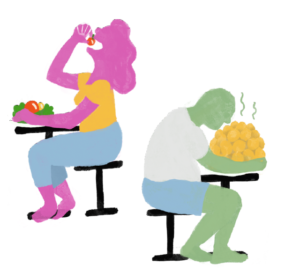
In recent years, our diets have become less healthy, less balanced and less nutrious. We’re eating more processed foods, more meat and more dairy than ever before. The livestock sector is booming (along with the deforestation it brings, as trees are cut down to make way for cattle-ranching and growing animal feed) and there is less and less economic incentive to avoid food waste. This is all thanks to our obsession with agricultural productivity. Farms are made to produce quantity over quality .
Trying to reduce world hunger simply by producing more means that world diets are becoming dependent on uniform food products made from a limited number of cheap energy-guzzling commodities, rather than nutrient-rich fruits and vegetables which can be more expensive to grow.
It’s a flawed approach leftover from a bygone era. This focus on producing more, instead of producing better, emerged as a response to high global demand at a time when lack of access to food was a real issue. Whereas today, on a global scale, more people are affected by malnutrition from over-consuming calories than under-nutrition {4}.
5. Is the current food system a threat to ecosystems? YES!

This isn’t the only way that food production threatens biodiversity and ecosystems.
Synthetic fertilizers and overuse of manure are both significant causes of air pollution. In periods of rain, excess nutrients and sediment from poorly-managed soil can wash into rivers, causing algae to cover the water’s surface and suffocate the aquatic or marine life beneath.
When woodland, rainforest or wetland is converted into fields for crop production, precious habitats for wild animals, plants and other organisms are destroyed. Agriculture accounts for 80% of all conversions in how land is being used globally (known as land-use change). Between 1980 and 2000, 42 million hectares of tropical forest in Latin America were lost to cattle ranching, while 6 million hectares were lost to palm oil plantations in Southeast Asia.
6. Does the current food system contribute to climate change ? YES!

The way we produce food contributes significantly to climate change. The greenhouse gas emissions associated with agriculture, the destruction of habitats to make way for growing crops, and how our food is processed and transported, means that the food system accounts for roughly 30 % of all human-made emissions. Rising global temperatures are changing and displacing suitable habitats, with species either being obliged to move with them or risk extinction.
Climate change is not only partly caused by the current structure of the food system, but also affects it. It reduces yields and the nutritional quality of crops across many regions, which further increases the pressure to intensify production or convert more land to agriculture. As greenhouse gas emissions continue to rise, so does the need for us to replant trees and forests as a means to mitigate climate change. This, in turn, increases competition for land leading to more extreme and intensified farming.
7. Are there hidden costs in the current food system ? YES!
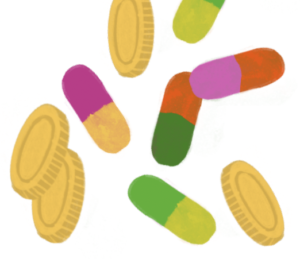
Incentives for production, global competition based on price, and long supply chains that reduce transparency together encourage the externalization of production costs on the environment and society as a whole. As a result, the farmers that produce food without externalizing costs struggle to be competitive in the market {5}.
According to research commissioned by the United Nations’ Food and Agriculture Organization (FAO), if we took the environmental costs of agriculture at global level into account, they would exceed the market value of the food being produced {6}. In the USA, the cost of air pollution alone on human health from agricultural production amount to about half its value {7}.
In 2013, the FAO estimated that healthcare costs from poor diets might exceed 5% GDP {8} each year.
This is likely to be an underestimate, as the direct costs of type II diabetes alone could amount to 4–5% of GDP {9} by 2025. By comparison, the added value of global agriculture to GDP was only 3.79% in 2015 {10}.
Artwork credit: OkayWhen
References
[1] Crowder, D.W., Reganold, J.P., 2015. Financial competitiveness of organic agriculture on a global scale. Proceedings of the National Academy of Sciences 112, 7611–7616
Reganold, J.P., Wachter, J.M., 2016. Organic agriculture in the twenty-first century. Nature Plants 2, 15221
2 France strategie, Les performances économiques et environnementales de l’agroécologie, August 2020
3 G. Gereffi and A.Abdulsaman, Measurement In A World of Globalized Production What are potential drivers of “unequal” value distribution in agri-food value chains? Center on Globalization, Governance and Competitiveness, Duke University 2017
4 T.G. Benton, R. Bailey, The paradox of productivity: agricultural productivity promotes food system inefficiency. Global Sustainability 2, e6, 1–8, 2019 https://doi.org/10.1017/sus.2019.3
5 T.G. Benton, R. Bailey, The paradox of productivity: agricultural productivity promotes food system inefficiency. Global Sustainability 2, e6, 1–8, 2019 https://doi.org/10.1017/sus.2019.3
6 FAO, Natural Capital Impacts in Agriculture: Supporting Better Business Decision-Making, 2015
7 Ibid.
8 FAO, State of Food and Agriculture 2013: Food systems for better nutrition.Rome, Italy, 2013
9 NCD-RisC, Worldwide trends in diabetes since 1980: a pooled analysis of 751 population-based studies with 4.4 million participants. The Lancet, 387(10027), 1513–1530, 2016 https://doi.org/10.1016/S0140-6736(16)00618-8
10 FAO, Natural Capital Impacts in Agriculture: Supporting Better Business Decision-Making, 2015
Full study and references
Read the full study on the impacts of the agro-industrial food system on food security and farmers’ income: Break out of the silo
*****
The Commission’s Farm to Fork Strategy: Why we are asking for more
The European Parliament will soon have to adopt its final position on this strategy. So far the Members of the European Parliament who are involved in the process support the reduction of the use of chemical pesticides and are also calling on the Commission to set national binding targets.
For the Farm To Fork strategy to be a success, the European Parliament is calling for:
- an end to exports of pesticides that are banned on EU soil
- to stop importing products containing pesticides that are banned in the EU
- to recognise the responsibility of farming to help mitigate climate change
- the decrease of the livestock density
On animal welfare and for consumers the Farm to Fork Strategy should include:
- the phase-out of cage-farming by 2027
- harmonised labelling identifying the method of production of animal products as well as animal welfare indicators.
- EU harmonised front-of-pack nutritional labels
- mandatory origin labelling for all ingredients
The European Parliament is demanding more flexibility for Member States to differentiate VAT rates on food to favour more healthy and sustainable products. Overall, the Farm to Fork Strategy should protect social rights for workers along the whole food chain, while highlighting that farmers are still among the poorest in Europe.
All these demands still need to be adopted by the plenary of the European Parliament on the 18th of October (TBC).
The EU Farm to Fork Strategy: Enough to save the CAP?
The Farm to Fork Strategy shows a last-ditch attempt of the Commission to fix our food system. But there’s an elephant in the room. Striving to green the EU’s food system will not be possible if the Common Agricultural Policy (CAP) (the second largest area of EU spending) works against the EU’s green objectives and does more harm to biodiversity and our climate.
As it stands now the Farm to Fork Strategy will not be able to make up for a failed CAP. Failing to make the CAP and our farming system in Europe sustainable will mean missing EU targets on climate, biodiversity and land degradation. The urgency of the climate crisis means that we cannot afford to miss the opportunity to shift now towards a robust and sustainable European agricultural model.
That is the reason we are calling to vote this CAP down to set up a new farming policy in line with the Farm to Fork strategy targets.
Stay up to date with votes on the Farm to Fork Strategy and on the CAP by signing up to our FOOD newsletter below.


Authors: Sarah Wiener and Tilly Metz ,Greens/EFA MEPs
More information:
Emmanuel Kujawski – Food and pesticides campaigner
emmanuel.kujawski@ep.europa.eu